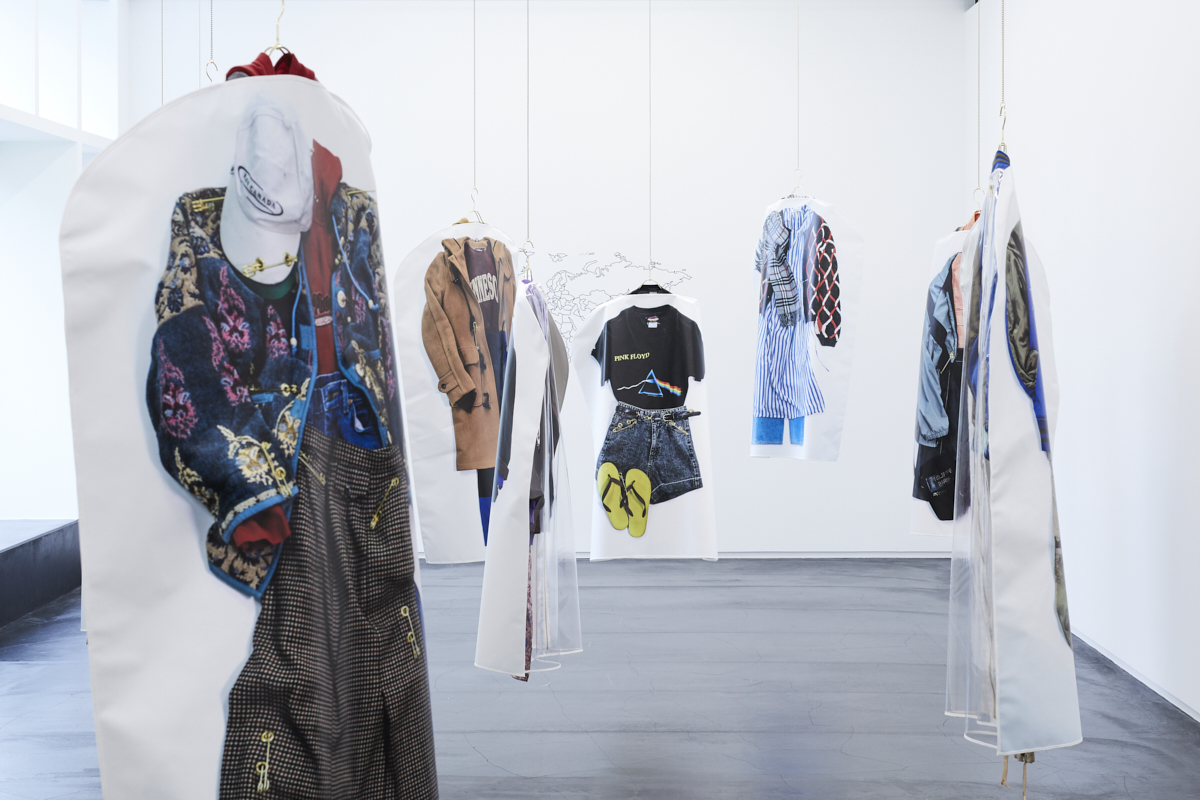

F
P
Jun 02, 2020
Jun 02, 2020

Special project: PUGMENT “Never Lonely”, installation view at Taka Ishii Gallery complex665, Jun 6 – 20, 2020. Photo: Kenji Takahashi
Special project: PUGMENT “Never Lonely”, installation view at Taka Ishii Gallery complex665, Jun 6 – 20, 2020. Photo: Kenji Takahashi

Special project: PUGMENT “Never Lonely”, installation view at Taka Ishii Gallery complex665, Jun 6 – 20, 2020. Photo: Kenji Takahashi
Special project: PUGMENT “Never Lonely”, installation view at Taka Ishii Gallery complex665, Jun 6 – 20, 2020. Photo: Kenji Takahashi
本作品は、出身地を遠く離れて日本へやってきた洋服を移民に見立て制作されています。展示されている服は、日本に輸入された海外製品の古着を異なる生産国同士で組み合わせ、安全ピンで接合しています。服を包むターポリン素材の衣類カバーには、日本のファッション誌で古くからある「置き画」という方法で撮影した写真が印刷されています。置き画とは、服を人に着せずに平面に置いた状態で撮影する手法です。置き画の歴史を紐解くと、1868年に遡ります。日本の洋装は、主に明治天皇が洋装化を指導したことからヨーロッパから流入し、その後1945年にGHQによる占領でアメリカの日常着が流入した時期を通して一般化しました。和服は一着に小物を添え完結するのに対し、洋服は複数のアイテムを組み合わせて着用するため、日本人向けの雑誌上でコーディネートを指南するために置き画という撮影方法が生まれました。また、洋服同士を接合するのに使われている安全ピンは、2016年に英国で欧州連合離脱が決定した際や、ドナルド・トランプが米大統領選で勝利した後に、移民やマイノリティグループに対してのヘイトクライムに対抗する意思を示すために安全ピンを服につける運動を参照しています。異なる時代や文化の要素が集まり混ざることで新たなアイデンティティが生まれる時代背景と、海外文化の流入により独自の文化を発展させてきた戦後日本の服飾史を共通したプロセスと捉え、本作品に重ね合わせています。
This work takes articles of clothing, which have traveled far from their origins to arrive in Japan, as immigrants. The exhibited items are produced by safety pinning pieces of used clothing produced in various nations and imported to Japan. The tarpaulin clothes covers are printed with photographs shot of clothes laid flat in okiga format. Okiga is a way of photographing clothing unworn and laid on a flat surface. Okiga has long been used in Japanese fashion magazines and its history harkens to 1868. Western clothing was first imported from Europe primarily on the Meiji Emperor’s instructions for Japanese citizens to Westernize their dress. Later, in 1945, GHQ Occupation brought American quotidian culture into Japan, and Western clothing was adopted generally.
While assembling a traditional Japanese outfit only requires the selections of one main item of clothing and accessories, Western clothing requires multiple items to be chosen. The okiga style of shooting clothing items was developed specifically for suggesting Western clothing ensembles in fashion magazines. The safety pins used to suture the pieces of used clothing references the wearing of safety pins by those in Europe and the US to protest hate crimes perpetrated against immigrants and minorities after the US presidential election of Donald Trump and the decision for the UK to leave the EU.
The work thus overlays the temporal context of various historical periods and cultural elements assembling and mixing to produce new identities, and the postwar history of Japanese fashion, which has produced its own legacy by importing foreign cultural elements.
PUGMENT
Never Lonely、2020年
ヴィデオ
3分27秒
写真|鈴木親、夢一平and下馬場貴志
ヘアメイク|Amano
サウンド|ヨシザワ”MAURICE”マサトモ、ハットリ”SHORTY”ヤスヒコ
モデル|原島隆斗
PUGMENT
Never Lonely, 2020
Video
3’27”
Director of Photography|Chikashi Suzuki, Yume Ippei and Takashi Shimobaba
Hairmake|Amano
Sound|Masatomo”MAURICE”Yoshizawa, Yasuhiko”SHORTY”Hattori
Model|Takato Harashima
PUGMENTの作品の多くは、現代に流通する日常着についての考察を起点として、洋装化以降の日本の服飾史や文化の変遷、衣服と人・都市・社会との関係に焦点をあてた丹念なリサーチに基づきます。路上に落ちている衣服をiPhoneで撮影し、同じ形の既製服の全面に転写することで衣服を再現する「MAGNETIC DRESS」(2014年)、古着のミリタリーウェアを燃やした灰で衣服を作る「IMAGE」(2016年)、インターネットで収集した衣服の写真を切り抜き、ターポリンに印刷して衣服を作る「Spring 2018」(2017年)、人類滅亡後の世界で、意思や感情を持ったファッションが衣服に憑依するという架空のストーリーを組み立て、近未来の防護服をイメージした服が登場する「1XXX-2018-2XXX」(2018年)、原宿を中心として発展した日本のファッション史に焦点を絞った「Purple Plant」(2019年)など、写真、映像、パフォーマンスなどの多様なメディアを用いてコレクションを発表してきました。いずれの作品も、衣服が持っている文脈や背景が、ファッションのみならず歴史や社会にどうリンクしているのかを観察する視点を持っています。ファッションのもつ消費サイクルと流行、その破壊の力までをも視野に入れ、流通システムそのものの性質を俯瞰しながらも、皮肉な自己言及のみに陥らず、デザイナーが自らそれをポジティブに再変換しようとする思考に溢れ、過去の歴史と現在が錯綜する状況が作品の中に生まれています。2020年5月にはプロジェクト「Pugment Books」をローンチ、過去に発表したコレクションの制作過程で生まれた写真やテキストをもとに、本の1ページに見立ててデザインしたアイテムを展開しています。PUGMENTの複眼的なアプローチは作品だけにとどまらず、その活動や制作プロセスを展覧会として公開したり、ギャラリー、書店、セレクトショップとジャンルの異なる会場で同時多発的に展覧会を行う姿勢にも表れています。そこには様々な隔たりを超えて人々を繋ぐことへの意識と、人の営みを通して衣服を制作することへの関心が貫かれています。
Many of PUGMENT’s works begin with observations of contemporary vernacular clothing and are based on careful research focusing on the histories and transformations of Japanese culture and clothing, as well as the relations between city, clothing, people, and society. PUGMENT has consistently released its collections using various media such as photography, video, and performance. Its MAGNETIC DRESS (2014) was made by photographing clothes found on the street with an iPhone, and printing the photograph onto a readymade and identically shaped clothing item. IMAGE (2016) comprised clothes made with ashes from burnt used military clothing. For Spring 2018 (2017), PUGMENT cut out photographs of used military clothes culled from the internet, printed them on tarpaulin, and made clothes out of it. 1XXX-2018-2XXX (2018) featured clothes that evoked protective gear of a near future, the setting of a fictional post-apocalyptic narrative, in which humans are extinct and fashion becomes dependent on clothing with will and emotion. Purple Plant (2019) focused on the history of contemporary Japanese fashion, much of which has come out of Harajuku. All of these works pay attention to the way in which clothing is linked not only to fashion, but also sociohistorical contexts. Producing works that complicate the relations between the past and present, PUGMENT also addresses fashion’s cycles of consumption and trends, and their destructiveness. With an understanding also of the way fashion’s distribution systems work, PUGMENT has devoted itself to transforming fashion’s issues into creative, positive output instead of simply generating ironic, self-referential statements.
In May 2020, PUGMENT launched its “Pugment Books” project, in which items are designed, based on photographs and texts produced in the process of creating previous season’s collections, as if they were a book page. PUGMENT’s multi-perspective approach is evinced not only in its collections and other works, but also its exhibitions, which are held simultaneously in multiple places such as galleries, bookstores, and curated shops, and feature a variety of activities and production processes.
PUGMENT
—
2014年に大谷将弘と今福華凜(ともに1990年東京生まれ)によって創設されたファッションレーベル。東京を拠点に活動。人の営みを通して服の価値や意味が変容していくプロセスを観察し、服の制作工程に組み込む。ファッションにまつわるイメージと人との関係性に着目し、既にある価値・環境・情報について別の視点を持つための衣服を発表する。 主な発表として「写真とファッション 90年代以降の関係性を探る」東京都写真美術館(東京、2020年)、「MOTアニュアル2019 Echo after Echo:仮の声、新しい影」東京都現代美術館(東京、2019年)、「We People Work」People / NADiff Gallery(東京、2019年)、「1XXX‒2018‒2XXX」KAYOKOYUKI / Utrecht / n id a deux(東京、2018年)などが挙げられる。「Unseen Amsterdam」(アムステルダム、2017年)にて写真家の小林健太と協働しパフォーマンスを実施。2019年5月にショップとオフィスの機能を兼ねたスタジオ「People」を恵比寿にオープンし、参加型ワークショップの開催などの実験的な活動を行っている。 PUGMENT.COM
PUGMENT
—
A Tokyo-based fashion label founded by Karin Imafuku and Masahiro Otani (both b.1990 in Tokyo) in 2014. Through observation of the transformation process in value and meaning of clothing in human activity, we incorporate this spirit into the production process of their clothes. Focusing on the relationship between human and images concerning fashion, we create and exhibit clothing in order to find different viewpoints on existing values, environments, and information. Recently, we presented in “Photography and Fashion Since the 1990s” at Tokyo Photographic Art Museum, Tokyo, 2020. “MOT Annual 2019 Echo after Echo : Summoned Voices, New Shadows” at Museum of Contemporary Art Tokyo, Tokyo, 2019. “1XXX‒2018‒2XXX” at KAYOKOYUKI, Utrecht and n id a deux, Tokyo, 2018. PUGMENT collaborated with photographer Kenta Cobayashi on a performance at “Unseen Amsterdam” (2017). In May 2019, PUGMENT opened in Ebisu, Tokyo, “People,” a space that combines office, studio, and retail, where participatory workshops and other experimental activities are carried out. PUGMENT.COM